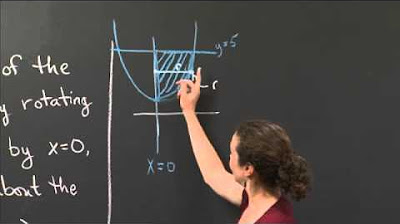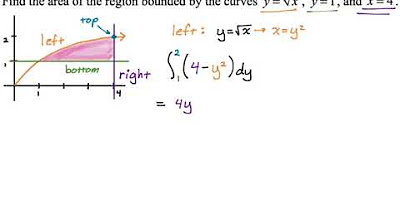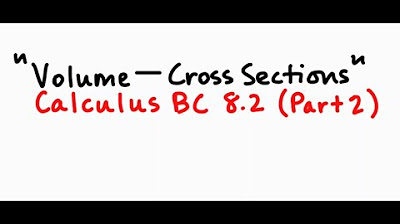2022 AP Calculus BC Exam FRQ #5
TLDRThis video tutorial tackles a multifaceted problem from the 2022 Calculus BC exam, which involves finding areas, volumes, and dealing with improper integrals and integration by parts. The presenter begins by addressing the area of a region bounded by y=1/x, the x-axis, and the lines x=1 and x=5, which is calculated using the integral from 1 to 5 of 1/x dx. The area is determined to be the natural logarithm of 5. Next, the video explores the volume of a solid with cross-sections perpendicular to the x-axis, defined by the area x * e^(x/5). Using integration by parts, the volume is found to be 20 * e^(1/5). Lastly, the video delves into the volume of a solid formed by revolving region W, bounded by y=1/x^2 and the x-axis, around the x-axis. This leads to an improper integral which, after careful calculation, results in a finite volume of π/81. The video concludes with the presenter's intention to continue with the next problem in a subsequent video, offering a comprehensive and engaging walkthrough of complex calculus concepts.
Takeaways
- 📚 The video covers problem number five from the 2022 Calculus BC exam, which involves area, volume, improper integral, and integration by parts.
- 📈 The first part of the problem is to find the area of region R, bounded by y=1/x, the x-axis, and the vertical lines x=1 and x=5, which is calculated as the integral from 1 to 5 of 1/x dx.
- ✅ The antiderivative of 1/x is the natural logarithm of the absolute value of x, leading to the result of ln(5) for the area of region R.
- 📏 For the volume of a solid with a cross-section perpendicular to the x-axis given by x * e^(x/5), the volume is found by integrating this area from 1 to 5.
- 🧩 The volume calculation involves integration by parts, where u is chosen as x and dv as e^(x/5), followed by finding du, v, and applying the integration by parts formula.
- 🔍 After applying integration by parts, the volume calculation simplifies to evaluating the expression at the bounds and subtracting, resulting in a simplified expression of 20e^(1/5).
- 🌀 The volume of the solid generated by revolving region W (bounded by y=1/x^2 to the right of the vertical line) around the x-axis is an improper integral with the upper bound of infinity.
- 📝 The improper integral is set up using the limit as b approaches infinity, and the integral from 3 to b of 1/x^4, which is solved using the fundamental theorem of calculus.
- ∞ As b approaches infinity, the term 1/(3b^3) approaches zero, leading to the final volume result of π/81 after considering the bounds and the limit.
- 🎯 The video emphasizes the importance of proper notation, especially when dealing with infinite bounds, to avoid losing points in an exam setting.
- ✨ The video concludes with the presenter expressing hope that the explanation is helpful and wishing the viewers good luck, indicating the end of the problem discussion.
Q & A
What is the main topic of the video?
-The video focuses on solving problem number five from the 2022 Calculus BC exam, which involves area, volume, improper integral, and integration by parts.
What are the two figures shown in the video?
-The two figures shown in the video illustrate regions in the first quadrant associated with the graphs of y = 1/x and y = 1/x^2.
What is the area of region R in the first figure?
-The area of region R is found by integrating 1/x from 1 to 5, which results in the natural logarithm of 5.
How is the volume of the solid in the second part of the video calculated?
-The volume of the solid is calculated by integrating the area of the cross-section perpendicular to the x-axis from 1 to 5, which is given by x * e^(x/5) dx.
What is the method used to integrate x * e^(x/5)?
-Integration by parts is used, where u is chosen as x and dv as e^(x/5), then applying the formula for integration by parts: ∫u dv = uv - ∫v du.
What is the final simplified form of the volume of the solid?
-The final simplified form of the volume is 20 * e^(1/5).
What is the region W in the third part of the video?
-Region W is the unbounded region between the graph of y = 1/x^2 and the x-axis to the right of the vertical line.
How is the volume of the solid generated when region W is revolved about the x-axis calculated?
-The volume is calculated using an improper integral from 3 to infinity of π * (1/x^4), which represents the area of the cross-section perpendicular to the x-axis.
What is the final answer for the volume of the solid generated by revolving region W about the x-axis?
-The final answer for the volume is π/81.
Why is it interesting that the volume is finite even though the region is infinite?
-It is interesting because the nature of the function 1/x^4 decreases rapidly enough as x approaches infinity to result in a finite volume despite the region being unbounded.
What is the importance of using proper notation when dealing with infinite limits?
-Using proper notation such as 'limit as b approaches infinity' is important for mathematical accuracy and clarity, and omitting it or using infinity as an upper bound directly can lead to incorrect calculations or loss of points in an academic context.
What is the significance of the natural logarithm function in the area calculation of region R?
-The natural logarithm function is significant as it is the antiderivative of 1/x, which is used to calculate the area under the curve y = 1/x from x = 1 to x = 5.
Outlines
📚 Calculus BC Exam Problem: Area and Volume Calculations
This paragraph introduces a problem from the 2022 Calculus BC exam focusing on area, volume, improper integral, and integration by parts. The problem involves calculating the area of a region bounded by y=1/x between x=1 and x=5, which is done by integrating 1/x to get the natural logarithm of 5 as the result. It then discusses the volume of a solid with a cross-section area given by x * e^(x/5), which is solved using integration by parts. The process involves choosing appropriate u and dv, integrating, and applying the fundamental theorem of calculus to find the volume as 20 * e^(1/5). The paragraph concludes with the setup for finding the volume of a solid generated by revolving region W about the x-axis, which involves an improper integral from 3 to infinity.
🔍 Solving the Improper Integral for the Solid's Volume
The second paragraph delves into solving an improper integral to find the volume of a solid formed by revolving region W around the x-axis. The region W is between y=1/x^2 and the x-axis to the right of the line. The integral is set up with the limit as b approaches infinity, and the integral from 3 to b of 1/x^4, which is simplified using the power rule. The solution process involves substituting the limits into the integral, simplifying the expression, and applying the fundamental theorem of calculus. The final result is obtained as pi/81, indicating a finite volume for the infinite region, which the speaker finds interesting and somewhat bizarre. The paragraph ends with a note that the problem is complete, and the speaker promises to return for another video to tackle the next problem.
Mindmap
Keywords
💡Improper Integral
💡Integration by Parts
💡Natural Logarithm
💡Anti-derivative
💡Solid of Revolution
💡Cross-Section Area
💡Fundamental Theorem of Calculus
💡Limits of Integration
💡Exponential Function
💡Volume Calculation
💡Region R
Highlights
The video covers problem number five from the 2022 Calculus BC exam, which involves area, volume, improper integral, and integration by parts.
Figures one and two illustrate regions in the first quadrant associated with the graphs of y = 1/x and y = 1/x^2 respectively.
Part A of the problem is to find the area of region R bounded by y = 1/x, the x-axis, and the vertical lines x = 1 and x = 5.
The area of region R is calculated using the integral from 1 to 5 of 1/x dx, resulting in the natural log of 5.
The base of a solid for the solid at each x is a rectangle with area given by x * e^(x/5), and the volume is found by integrating this area from 1 to 5.
Integration by parts is used to solve the integral of x * e^(x/5), with u chosen as x and dv as e^(x/5).
After applying integration by parts, the volume of the solid is simplified to 20 * e^(1/5).
The volume of the solid generated when region W is revolved about the x-axis is found using an improper integral from 3 to infinity.
The integral involves the function 1/x^4, which is integrated using the power rule, resulting in -1/(3b^3) as b approaches infinity.
The final answer for the volume of the solid is pi/81, indicating a finite volume for an infinite region.
The video emphasizes the importance of proper notation, especially when dealing with infinite bounds in integrals.
The presenter uses the fundamental theorem of calculus to evaluate the definite integrals.
The video demonstrates how to handle absolute values and the natural logarithm function in integration.
The process of simplifying expressions, especially when dealing with exponential functions, is shown to avoid complex calculations.
The video provides a step-by-step approach to solving the problem, making it accessible for learners.
The presenter mentions that they will return in another video to tackle problem number six from the same exam.
The video concludes with a wish for the viewers to find the content helpful and luck in their studies.
Transcripts
Browse More Related Video

Volume with cross sections: squares and rectangles (no graph) | AP Calculus AB | Khan Academy

2012 AP Calculus AB Free Response #2

Volume of a Paraboloid via Disks | MIT 18.01SC Single Variable Calculus, Fall 2010

Area Between Curves: Integrating with Respect to y (Example 2)

Area Between Curves: Integrating with Respect to y (Example 3)

Volume of Solids with Known Cross Sections
5.0 / 5 (0 votes)
Thanks for rating: